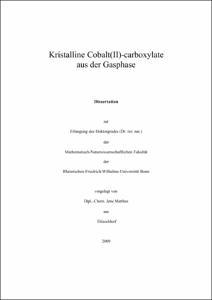Kristalline Cobalt(II)-carboxylate aus der Gasphase

Kristalline Cobalt(II)-carboxylate aus der Gasphase

| dc.contributor.advisor | Beck, Johannes | |
| dc.contributor.author | Matthes, Jens | |
| dc.date.accessioned | 2020-04-15T12:54:44Z | |
| dc.date.available | 2020-04-15T12:54:44Z | |
| dc.date.issued | 01.04.2010 | |
| dc.identifier.uri | https://hdl.handle.net/20.500.11811/4543 | |
| dc.description.abstract | In dieser Arbeit wurde systematisch das thermische Verhalten von Cobalt(II)-carboxylat-hydraten untersucht und mit dem Verhalten von Cobalt(II)-acetat-tetrahydrat, von dem bekannt war, dass es in der Massenspektrometrie Cluster der Zusammensetzung [Co4O(O2CCH3)6]+ bildet[21,22] sowie bei Temperaturen von 250 °C im kontinuierlich gepumpten Vakuum ein blau-violettes, kristallines Sublimat bildet[33], verglichen. Die Cobalt(II)-carboxylat-hydrate Cobalt(II)-trimethylacetat, Cobalt(II)-dimethylacetat, Cobalt(II)-butanoat, Cobalt(II)-trifluoracetat, Cobalt(II)-propionat und Cobalt(II)-benzoat zeigten in der massenspektrometrischen Fragmentierung die Bildung von Clustern der Zusammensetzung [Co4O(O2CR)6]+. Weiterhin bilden sich im kontinuierlich gepumpten Vakuum ab 150 °C Sublimationsprodukte, die in kristalliner Form abgeschieden wurden und deren Struktur durch Röntgenbeugung aufgeklärt werden konnten. Cobalt(II)-trimethylacetat-trihydrat und Cobalt(II)-dimethylacetat-trihydrat bilden als Sublimationsprodukt das entsprechende wasserfreie Cobalt(II)carboxylat, welches jeweils in einer Kettenstruktur kristallisiert (Abb. 10.1). Cobalt(II)-butanoat-dihydrat bildet als Sublimationsprodukt Tetracobalt-hexakis(butanoat)-oxid, welches ebenfalls in einer Kettenstruktur kristallisiert (Abb. 10.1), Cobalt(II)-trifluoracetat-tetrahydrat bildet als Sublimationsprodukt Tetracobalt(II)-Dinatrium(I)-oktakis(trifluoracetat)-oxid, welches in einer Schichtstruktur kristallisiert. Die Natriumatome stammen aus einer Reaktion mit der Glaswand der Ampulle. Cobalt(II)-benzoat-trihydrat bildet zwei Sublimationsprodukte, zum einen wasserfreies Cobalt(II)-benzoat, welches in einer Kettenstruktur kristallisiert, zum anderen Tetracobalt(II)-hexakis(benzoat)-oxid, welches in einer Molekülstruktur kristallisiert. Cobalt(II)-propionat-trihydrat bildet drei Sublimationsprodukte, zum einen Tetracobalt(II)-hexakis(propionat)-oxid welches in einer Kettenstruktur kristallisiert, zum anderen Pentacobalt(II)-oktakis(propionat)-oxid, welches ebenfalls in einer Kettenstruktur kristallisiert und außerdem noch Hexacobalt(II)-undekakis(propionat)-hydroxid, welches in einer Schichtstruktur kristallisiert. Abb. 10.1: Zwei Kettenstrukturen von Cobalt(II)-carboxylaten. Rechts ist die Struktur von wasserfreiem Cobalt(II)-dimethylacetat, links ist die Struktur von Tetracobalt-hexakis(butanoat)-oxid gezeigt. Schließlich konnte gezeigt werden, dass auch gemischte Cobalt(II)-magnesium(II)-carboxylat-hydrate im kontinuierlich gepumpten Vakuum Sublimationsprodukte bilden. Im Massenspektrum von Cobalt(II)-magnesium(II)benzoat-hydrat wurden Cluster der Zusammensetzung [M4O(O22CC6H5)6]+, wobei M ein beliebiges Verhältnis von Cobalt zu Magnesium annehmen kann, nachgewiesen. Außerdem wurde bei 150 °C ein Sublimationsprodukt erhalten, welches in kristalliner Form abgeschieden wurde und dessen Struktur durch Röntgenbeugung aufgeklärt werden konnte. Das Sublimationsprodukt wurde als wasserfreies Cobalt(II)-magnesium(II)-tetrabenzoat charakterisiert und kristallisiert in einer Kettenstruktur. In allen Strukturen haben die Carboxylatgruppen grundsätzlich verbrückende Funktionen an den Cobaltatomen. Es existieren jedoch zwei verschiedene Koordinationsmodi, µ2- und µ3-Verbrückungen, deren Prinzip in Abb. 10.2 dargestellt ist. Je höher der Verbrückungsgrad in einer Struktur, umso höher ist auch die Koordinationszahl am Cobaltatom. Abb. 10.2: Die Koordinationsmodi von Carboxylatgruppen: µ2-verbrückend links und µ3-verbrückend rechts. Einige Carboxylategruppen haben neben ihrer µ2- oder µ3-verbrückenden Funktion zusätzlich eine chelatisierende Funktion an einem Cobaltatom. Dabei ist stets eine der beiden Cobalt - Sauerstoff - Bindungen größer als 2.5 Å. Die Prinzipien dieser Koordination sind in Abb. 10.3 gezeigt. Abb. 10.3: Carboxylatgruppen mit chelatisierender und verbrückender Funktion. Links µ2-verbrückend, rechts µ3-verbrückend. | en |
| dc.description.abstract | Crystalline Cobalt(II)-carboxylate from gaseous phase It is a known fact that cobalt(II)-acetate-tetrahydrate is volatile when heated in vacuo to 250 °C. Blue sublimates of still unknown composition are deposited. The mass spectra of the vapour have already been studied several times and the cluster ions [Co4O(O2CCH3)6]+, [Co4O(O2CCH3)5]+ and [Co3O(O2CCH3)3]+ have been identified. In this work, the thermal behaviour of several cobalt(II)-carboxylates is systematically studied by mass spectrometry, differential thermal analysis, /thermogravimetry and by volatilisation in vacuo at temperatures up to 350 °C and compared with the behaviour of cobalt(II)-acetate-tetrahdrate. Accordingly, cobalt(II)-trimethylacetate-trihydrate, cobalt(II)-dimethylacetate-trihydrate, cobalt(II)-butanoate-dihydrate, cobalt(II)-trfluoracetate-tetrahydrate, cobalt(II)-propionate-trihydrate and cobalt(II)-benzoate-trihydrate also show the formation of multinuclear complexes [Co4O(O2CCR)6]+, [Co4O(O2CR)5]+ and [Co3O(O2CR)3]+ in their mass spectra. On heating to temperatures up to 150 °C these cobalt(II)-carboxylates are volatile and form solid sublimates. Single crystals could be deposited and the crystal structures of the sublimates were determined. The sublimates of cobalt(II)-trimethylacetate-trihydrate and cobalt(II)-dimethylacetate-trihydrate turned out as hydrate free cobalt(II)-carboxylates, both crystallizing in a polymeric chain structure. The sublimate of cobalt(II)-butanoate-dihydrate is actually tetracobalt(II)-hexakis(butanoate)-oxide and crystallizes in a polymeric chain structure. The sublimate of cobalt(II)-trifluoracetate-tetrahydrate is tetracobalt(II)-disodium(I)-octakis(trifluoracetate)-hydroxide and crystallizes in a layer structure. The source of the sodium is unknown, but probably originates from a reaction with the wall of the used glass ampoule. There are two different compounds deposited in the sublimation of cobalt(II)-benzoate-trihydrate. Hydrate free cobalt(II)-benzoate was found to crystallize in a polymeric chain structure and tetracobalt(II)-hexakis(benzoate)-oxide crystallizes in a molecular structure. There are three different compounds deposited on the sublimation of cobalt(II)-propionate-trihydrate. Tetracobalt(II)-hexakis(propionate)-oxide and pentacobalt(II)-octakis (propionate)-oxide crystallize in polymeric chain structures. Hexacobalt(II)-undecakis(propionate)-hydroxide crystallizes with a layered structure. The mass spectrometric fragmentation of mixed cobalt(II)-magnesium(II)-benzoate-hydrate shows the presence of mixed metal clusters [M4O(O2CC6H5)6]+, [M4O(O2CC6H5)5]+ and [M3O(O2CC6H5)3]+, M represents cobalt and magnesium in different amounts. The sublimate of cobalt(II)-magnesium(II)-benzoate-hydrate is hydrate free cobalt(II)-magnesium(II)-tetrakis(benzoate), crystallizing in a polymeric chain structure. | en |
| dc.language.iso | deu | |
| dc.rights | In Copyright | |
| dc.rights.uri | http://rightsstatements.org/vocab/InC/1.0/ | |
| dc.subject | Cobalt(II)-carboxylate | |
| dc.subject | Massenspektrometrie | |
| dc.subject | DTA/TG | |
| dc.subject | Cobalt(II)-Magnesium(II)-carboxylate | |
| dc.subject | Masspektrometry | |
| dc.subject | Cobalt(II)-Magnesia(II)-carboxylate | |
| dc.subject.ddc | 540 Chemie | |
| dc.title | Kristalline Cobalt(II)-carboxylate aus der Gasphase | |
| dc.type | Dissertation oder Habilitation | |
| dc.publisher.name | Universitäts- und Landesbibliothek Bonn | |
| dc.publisher.location | Bonn | |
| dc.rights.accessRights | openAccess | |
| dc.identifier.urn | https://nbn-resolving.org/urn:nbn:de:hbz:5N-20633 | |
| ulbbn.pubtype | Erstveröffentlichung | |
| ulbbnediss.affiliation.name | Rheinische Friedrich-Wilhelms-Universität Bonn | |
| ulbbnediss.affiliation.location | Bonn | |
| ulbbnediss.thesis.level | Dissertation | |
| ulbbnediss.dissID | 2063 | |
| ulbbnediss.date.accepted | 02.03.2010 | |
| ulbbnediss.institute | Mathematisch-Naturwissenschaftliche Fakultät : Fachgruppe Chemie / Institut für Anorganische Chemie | |
| ulbbnediss.fakultaet | Mathematisch-Naturwissenschaftliche Fakultät | |
| dc.contributor.coReferee | Glaum, Robert |
Files in this item
This item appears in the following Collection(s)
-
E-Dissertationen (4442)




